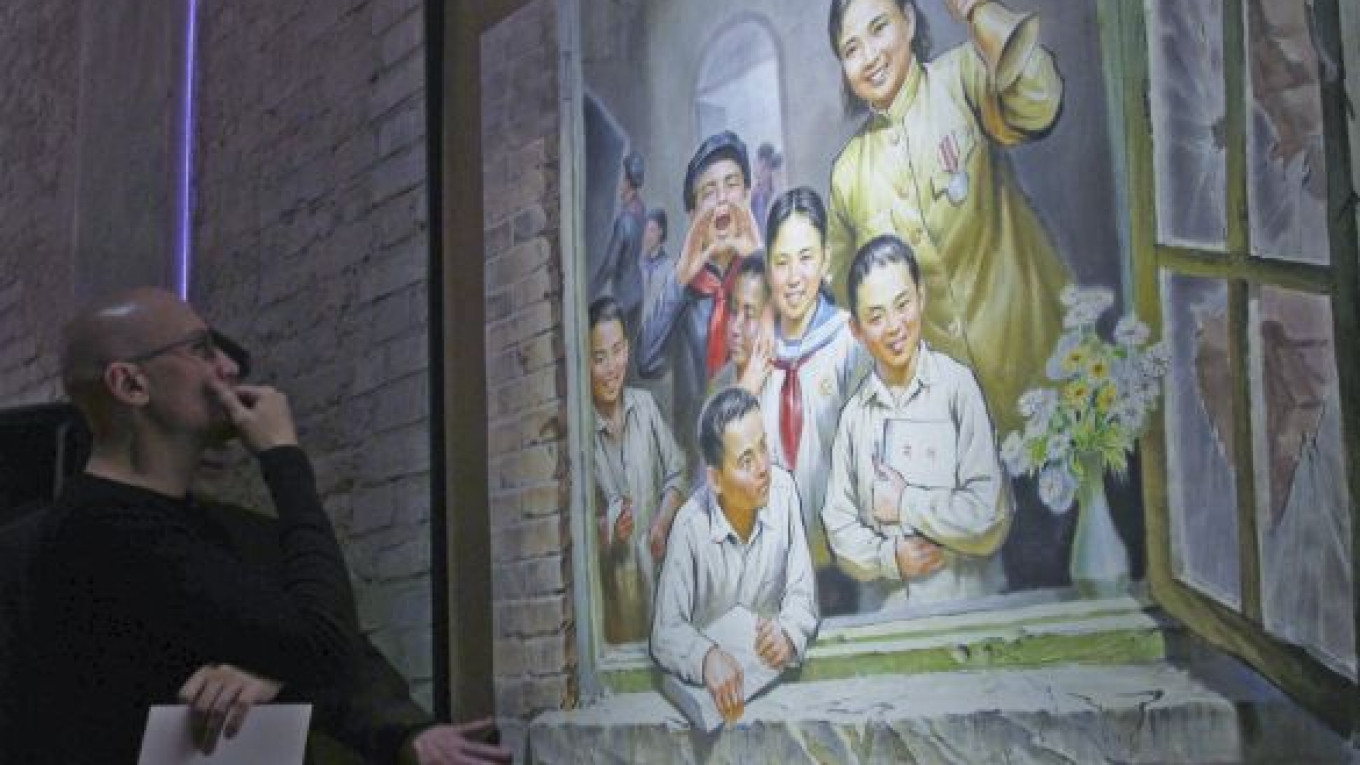Chubby-cheeked, hard-working and joyous but also ready for military action is how North Korea presents its people at a major show of official art from the secretive state.
“And Water Flows Beneath the Ice” exhibits 40 works by 39 state-commissioned artists that have never been shown abroad and span 25 years of tight North Korean rule.
Hardy women in overalls with windswept ponytails wade in rubber boots beside their male comrades in Pak Tong Chol’s “Pioneers of Taming the Western Sea” (2009). Sharing an innocent joke, the youths look happily ahead into the future.
Dozens of smiling steelworkers smelt and haul sheets of metal in a red flag-draped factory in Kim Su Dong’s “Front Workers of the Age of Songun” (2009). They appear to be having the time of their lives. All the art comes from Pyongyang’s Mansudae Art Studio, set up in 1959 and whose 1,000 artists are at the core of North Korea’s state-driven aesthetics. They designed the Pyongyang metro system and the capital’s socialist-realist statues.
But the curators of the Moscow exhibit — housed in the trendy Winzavod gallery, a revamped wine factory — insist that it is not to be confused with propaganda.
“Pure propaganda is not art. We are hoping visitors will see this as a national art form,” co-curator Anna Zaitseva said at the pink-carpeted and red-lit exhibit, which runs until the end of January.
Folksy, embroidered scenes of healthy seaweed-farm workers and hay gatherers from the 1990s are highly reminiscent of the socialist-realism used by the former Soviet Union as a political message to show the greatness of the state by applauding socialist triumphs.
Not all were convinced by the absence of politics at the exhibit, which does not feature North Korean leader Kim Jong Il. “My first impression is that I am so happy we [Russians] survived this period,” said business manager Igor Splavnik, 47.
Standing by a painting of chubby newborns in a shining new hospital, Splavnik said Russia’s Soviet past was to blame for North Korea’s politics, which experts say has caused mass starvation. “We should feed this nation,” he said.
North Korean art first entered the Western scene in 2007 with an exhibit in Italy, followed by one in Vienna last May.
Zaitseva, who has traveled to North Korea several times, said it is the artists’ technique — “Korean painting,” a 2,000 year old practice of ink on paper — that is behind the exhibit’s beauty, making it separate from politics.
“The key technology to this art — and it is the founding, most representative part of it — is that North Korea uses Korean painting. This makes it differ from Soviet realism,” she said, adding that oil paintings did not enter the scene until the 1970s.
But behind the delicate ink strokes on parchment, there is a stark message of North Korea’s military readiness — a chilling reminder of current tensions on the Korean Peninsula, which are at their highest in years. “Before a Fierce Battle” (2009) depicts two ferocious-looking soldiers surging forward toward a pile of gold bullets and handmade grenades while red smoke bellows above.
A heavily protected city is captured in “Tongil Avenue at Night,” where a multitude of cranes resembling machine guns and yellow sparks of light cover Pyongyang.
Hans Knoll, from Vienna’s Knoll Gallery and a partner in the Winzavod exhibit, said he will exhibit some of the works in other parts of Europe later this year.
Click here to watch a clip from the exhibition.
“And Water Flows Beneath the Ice” runs till Jan. 30 in the White Hall at the Winzavod Center for Contemporary Art. 1 4th Syromyatnichesky Pereulok, Bldg. 6. Metro Chkalovskaya, Kurskaya. www.winzavod.ru
A Message from The Moscow Times:
Dear readers,
We are facing unprecedented challenges. Russia's Prosecutor General's Office has designated The Moscow Times as an "undesirable" organization, criminalizing our work and putting our staff at risk of prosecution. This follows our earlier unjust labeling as a "foreign agent."
These actions are direct attempts to silence independent journalism in Russia. The authorities claim our work "discredits the decisions of the Russian leadership." We see things differently: we strive to provide accurate, unbiased reporting on Russia.
We, the journalists of The Moscow Times, refuse to be silenced. But to continue our work, we need your help.
Your support, no matter how small, makes a world of difference. If you can, please support us monthly starting from just $2. It's quick to set up, and every contribution makes a significant impact.
By supporting The Moscow Times, you're defending open, independent journalism in the face of repression. Thank you for standing with us.
Remind me later.






